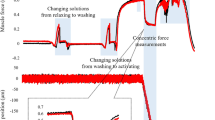Abstract
Caffeine ingestion by human athletes has been found to improve endurance performance primarily acting via the central nervous system as an adenosine receptor antagonist. However, a few studies have implied that the resultant micromolar levels of caffeine in blood plasma (70 μM maximum for humans) may directly affect skeletal muscle causing enhanced force production. In the present study, the effects of 70 μM caffeine on force and power output in isolated mouse extensor digitorum longus muscle were investigated in vitro at 35°C. Muscle preparations were subjected to cyclical sinusoidal length changes with electrical stimulation conditions optimised to produce maximal work. 70 μM caffeine caused a small but significant increase (2–3%) in peak force and net work produced during work loops (where net work represents the work input required to lengthen the muscle subtracted from the work produced during shortening). However, these micromolar caffeine levels did not affect the overall pattern of fatigue or the pattern of recovery from fatigue. Our results suggest that the plasma concentrations found when caffeine is used to enhance athletic performance in human athletes might directly enhance force and power during brief but not prolonged activities. These findings potentially confirm previous in vivo studies, using humans, which implied caffeine ingestion may cause acute improvements in muscle force and power output but would not enhance endurance.





Similar content being viewed by others
References
Allen DG, Westerblad H (1995) The effects of caffeine on intracellular calcium, force and the rate of relaxation in mouse skeletal muscle. J Physiol 487:331–342
Allen DG, Westerblad H (2001) Role of phosphate and calcium stores in muscle fatigue. J Physiol 536(3):657–665
Askew GN, Marsh RL (1997) The effects of length trajectory on the mechanical power output of mouse skeletal muscles. J Exp Biol 200:3119–3131
Askew GN, Marsh RL (1998) Optimal shortening velocity (V/Vmax) of skeletal muscle during cyclical contractions: length force effects and velocity dependent activation and deactivation. J Exp Biol 201:1527–1540
Brooks SV, Faulkner JA (1988) Contractile properties of skeletal muscles from young, adult and aged mice. J Physiol 404:71–82
Dickinson M, Farley C, Full R, Koehl M, Kram R, Lehman S (2000) How animals move: an integrative review. Science 288:100–106
Fredholm BB, Bättic K, Holmén J, Nehlic A, Zvartau EE (1999) Actions of caffeine in the brain with special reference to factors that contribute to its widespread use. Pharmacol Rev 51:83–133
Germinario E, Esposito A, Megighian A, Midrio M, Betto R, Danieli-Betto D (2004) Effects of modulators of sarcoplasmic Ca2+ release on the development of skeletal muscle fatigue. J Appl Physiol 96:645–649
Graham TE (2001) Caffeine and exercise. Metabolism, endurance and performance. Sports Med 31:785–807
James RS, Altringham JD, Goldspink DF (1995) The mechanical properties of fast and slow skeletal muscles of the mouse in relation to their locomotory function. J Exp Biol 198:491–502
James RS, Young IS, Cox VM, Goldspink DF, Altringham JD (1996) Isometric and isotonic muscle properties as determinants of work loop muscle power output. Eur J Physiol 432:767–774
James RS, Wilson RS, Askew GN (2004) The effects of caffeine on mouse skeletal muscle power output during recovery from fatigue. J Appl Physiol 96:545–552
Kalmar JM, Cafarelli E (1999) Effects of caffeine on neuromuscular function. J Appl Physiol 87:801–808
Lindinger MI, Graham TE, Spriet LL (1993) Caffeine attenuates the exercise-induced increase in plasma [K+] in humans. J Appl Physiol 74:1149–1155
Lopes JM, Aubier M, Jardim J, Aranda JV, Macklem PT (1983) Effect of caffeine on skeletal muscle function before and after fatigue. J Appl Physiol 54:1303–1305
Lorist MM, Tops M (2003) Caffeine, fatigue and cognition. Brain Cogn 53:82–94
Marsh RL (1999) How muscles deal with real-world loads: the influence of length trajectory on muscle performance. J Exp Biol 202:3377–3385
Méndez J, Keys A (1960) Density and composition of mammalian muscle. Metabolism 9:184–188
Paluska SA (2003) Caffeine and exercise. Curr Sports Med Rep 2:213–219
Plaskett CJ, Cafarelli E (2001) Caffeine increases endurance and attenuates force sensation during submaximal isometric contractions. J Appl Physiol 91:1535–1544
Reading SA, Murrant CL, Barclay JK (2004) Positive inotropism in mammalian skeletal muscle in vitro during and after fatigue. Can J Physiol Pharmacol 82:249–261
Rossi R, Bottinelli R, Sorrentino V, Reggiani C (2001) Response to caffeine and ryanodine receptor isoforms in mouse skeletal muscles. Am J Physiol 281:C585–C594
Spriet LL, Howlett RA (2000) Caffeine. In: Maughn RJ (ed) Nutrition and Sport. Blackwell Science, pp 379–392
Tarnopolsky M, Cupido C (2000) Caffeine potentiates low frequency skeletal muscle force in habitual and nonhabitual caffeine consumers. J Appl Physiol 89:1719–1724
Wakeling JM (2004) Motor units are recruited in a task-dependent fashion during locomotion. J Exp Biol 207:3883–90
Zaykin DV, Zhivotovsky LA, Westfall PH, Weir, BS (2002) Truncated product method for combining p-values. Genet Epidemiol 22:170–185
Acknowledgements
Tiana Kohlsdorf was a visiting postgraduate student supported by a FAPESP Doctoral Fellowship (00/06662-5) and travelling fellowships to the UK from Pró-reitoria de Pesquisa e Pós-graduação and Commissão de Cooperação Internacional (CCInt), both from University of São Paulo, Brazil. We thank: Drs. Mike Price, Graham Askew, Ray Carson, Anna Pike and participants in the Coventry University Physiology and Sport Science seminar series for helpful discussions; Mark Bodycote and Adrian Wallen for technical assistance. TK present address: Department of Ecology and Evolutionary Biology, Yale University. 165 Prospect St., New Haven, 06511 CT. USA.
Author information
Authors and Affiliations
Corresponding author
Rights and permissions
About this article
Cite this article
James, R.S., Kohlsdorf, T., Cox, V.M. et al. 70 μM caffeine treatment enhances in vitro force and power output during cyclic activities in mouse extensor digitorum longus muscle. Eur J Appl Physiol 95, 74–82 (2005). https://doi.org/10.1007/s00421-005-1396-2
Accepted:
Published:
Issue Date:
DOI: https://doi.org/10.1007/s00421-005-1396-2




